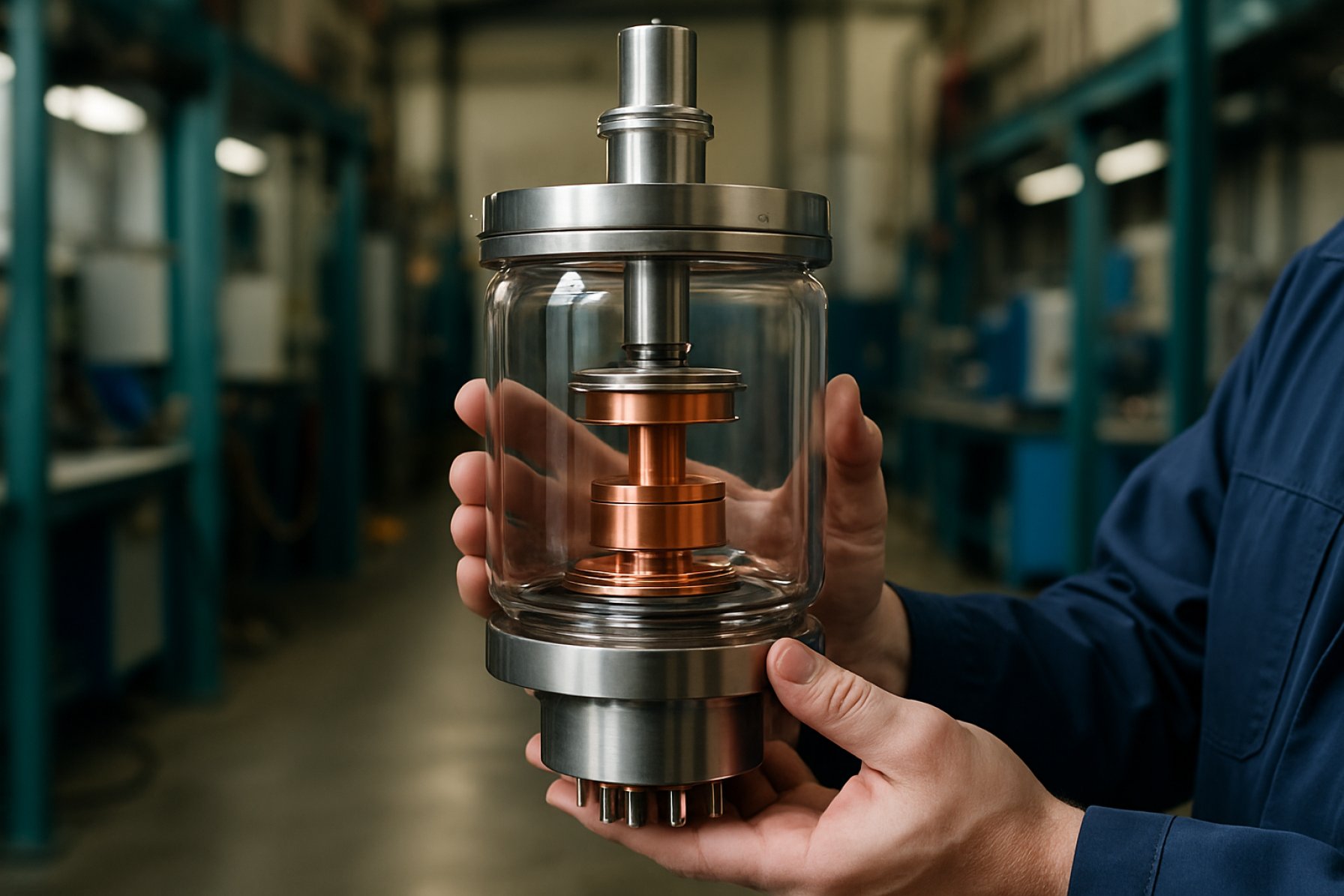High-Voltage Klystron Manufacturing in 2025: Navigating Technological Breakthroughs and Market Expansion. Discover How Industry Leaders Are Shaping the Next Generation of High-Power RF Solutions.
- Executive Summary: 2025 Market Landscape
- Key Industry Players and Official Partnerships
- Technological Innovations in High-Voltage Klystrons
- Manufacturing Processes and Quality Standards
- Global Market Size, Segmentation, and 2025–2030 Forecasts
- Emerging Applications: Particle Accelerators, Radar, and Beyond
- Supply Chain Dynamics and Raw Material Sourcing
- Regulatory Environment and Industry Standards
- Competitive Analysis: Strategies of Leading Manufacturers
- Future Outlook: Opportunities, Challenges, and Strategic Recommendations
- Sources & References
Executive Summary: 2025 Market Landscape
The high-voltage klystron manufacturing sector in 2025 is characterized by robust demand, technological innovation, and strategic investments, driven primarily by the needs of particle accelerators, medical linear accelerators, radar systems, and advanced scientific research. Klystrons, as high-power vacuum electron devices, remain indispensable for generating and amplifying microwave and radio frequency (RF) signals at high voltages, with applications spanning from national laboratories to industrial and defense sectors.
Key industry players continue to shape the competitive landscape. Communications & Power Industries (CPI) stands as a global leader, supplying high-voltage klystrons for major accelerator projects and medical systems worldwide. Thales Group maintains a strong presence in Europe and Asia, focusing on both research and commercial applications, while Toshiba Corporation is a dominant supplier in Asia, particularly for large-scale scientific facilities and medical equipment. Canon Inc. (through its Canon Electron Tubes & Devices division) and Hitachi, Ltd. also contribute significantly, especially in the Japanese and broader Asian markets.
In 2025, the sector is witnessing increased investment in R&D to improve klystron efficiency, reliability, and operational lifespans. This is in response to the growing requirements of next-generation accelerators, such as those under development at major research institutions and national laboratories. For example, the European Organization for Nuclear Research (CERN) and the U.S. Department of Energy’s national labs continue to drive demand for high-performance klystrons for both upgrades and new projects.
Supply chain resilience remains a focal point, as manufacturers address challenges related to the sourcing of high-purity materials and precision components. The sector is also adapting to evolving environmental and regulatory standards, particularly regarding the use of hazardous materials and energy efficiency in manufacturing processes.
Looking ahead, the outlook for high-voltage klystron manufacturing is positive. The global push for advanced scientific infrastructure, expansion of cancer radiotherapy facilities, and modernization of defense radar systems are expected to sustain and potentially accelerate demand. Strategic collaborations between manufacturers and research institutions are likely to intensify, fostering innovation and ensuring the sector’s continued relevance in the face of emerging solid-state alternatives. However, the high technical barriers and capital requirements will continue to limit new entrants, consolidating the market among established players such as Communications & Power Industries, Thales Group, and Toshiba Corporation.
Key Industry Players and Official Partnerships
The high-voltage klystron manufacturing sector in 2025 is characterized by a concentrated group of established players, strategic partnerships, and ongoing investments in advanced vacuum electronics. The market is dominated by a handful of global companies with decades of experience in high-power RF and microwave technologies, serving applications in particle accelerators, radar, satellite communications, and scientific research.
One of the most prominent manufacturers is Communications & Power Industries (CPI), headquartered in the United States. CPI is recognized for its extensive portfolio of high-voltage klystrons, including continuous wave and pulsed variants, and is a key supplier to major accelerator facilities and defense programs worldwide. The company maintains long-term supply agreements with national laboratories and research consortia, such as those supporting the European XFEL and CERN’s accelerator upgrades.
In Europe, Thales Group stands out as a leading manufacturer, particularly through its Microwave & Imaging Subsystems division. Thales supplies high-power klystrons for scientific, medical, and industrial applications, and is a core partner in several European research infrastructure projects. The company’s collaborations with organizations like the European Organization for Nuclear Research (CERN) and the European Spallation Source (ESS) underscore its strategic role in the region’s high-voltage RF ecosystem.
Japan’s Toshiba Corporation is another major player, with a long history of supplying klystrons for both domestic and international accelerator projects. Toshiba’s Electron Tube & Devices division is known for its high-reliability klystrons used in medical linacs, broadcast transmitters, and large-scale scientific facilities. The company has ongoing partnerships with Japanese research institutes and is involved in global projects such as the International Linear Collider (ILC).
Other notable contributors include Hitachi High-Tech Corporation in Japan, which manufactures specialized klystrons for research and industrial use, and L3Harris Technologies in the United States, which provides high-power vacuum electronic devices for defense and space applications.
Looking ahead, the industry is expected to see further consolidation of expertise through joint ventures and public-private partnerships, particularly as demand grows for next-generation accelerators and high-power RF systems. Official collaborations between manufacturers and research institutions are likely to intensify, with a focus on improving efficiency, reliability, and scalability of high-voltage klystron technology.
Technological Innovations in High-Voltage Klystrons
The manufacturing landscape for high-voltage klystrons is undergoing significant transformation in 2025, driven by advances in materials science, precision engineering, and digital manufacturing techniques. High-voltage klystrons, essential for particle accelerators, radar systems, and satellite communications, require stringent quality control and innovation to meet the increasing demands for higher power, efficiency, and reliability.
One of the most notable trends is the integration of advanced ceramics and composite materials in the fabrication of vacuum envelopes and electron gun assemblies. These materials offer superior dielectric strength and thermal stability, enabling klystrons to operate at higher voltages and power levels. Leading manufacturers such as Communications & Power Industries (CPI) and Toshiba Corporation have reported ongoing investments in material research to enhance the longevity and performance of their high-voltage klystron lines.
Precision in electron beam alignment and cavity machining has also improved, thanks to the adoption of computer numerical control (CNC) systems and in-line metrology. These technologies allow for tighter tolerances and more consistent product quality, which is critical for high-voltage operation. Thales Group, a major supplier of klystrons for scientific and defense applications, has highlighted the role of digital twins and simulation-driven design in reducing prototyping cycles and accelerating time-to-market for new klystron models.
Automation is increasingly present on the manufacturing floor, with robotic assembly and automated vacuum brazing processes reducing human error and improving throughput. This is particularly relevant as global demand for high-voltage klystrons grows, spurred by large-scale accelerator projects in Europe, Asia, and North America. Companies like Communications & Power Industries and Toshiba Corporation are expanding their production capacities and modernizing facilities to meet these needs.
Looking ahead, the outlook for high-voltage klystron manufacturing is shaped by the push for higher efficiency and lower maintenance requirements. Research into additive manufacturing (3D printing) of complex RF components is underway, with the potential to further reduce costs and enable rapid customization. Industry leaders are also collaborating with research institutions to develop next-generation klystrons capable of supporting emerging applications such as compact accelerators and advanced medical imaging systems.
In summary, 2025 marks a period of rapid technological innovation in high-voltage klystron manufacturing, characterized by material advancements, digitalization, and automation. These trends are expected to continue over the next few years, positioning established manufacturers and their partners at the forefront of a dynamic and evolving sector.
Manufacturing Processes and Quality Standards
High-voltage klystron manufacturing in 2025 is characterized by a combination of precision engineering, advanced materials science, and rigorous quality assurance protocols. Klystrons, as high-power vacuum electron devices, are essential for applications in particle accelerators, radar, and satellite communications, demanding both reliability and performance at extreme voltages. The manufacturing process typically begins with the fabrication of high-purity metal components, such as cathodes, anodes, and resonant cavities, often using materials like oxygen-free copper and specialized ceramics for insulation. These components are machined to tight tolerances, frequently within microns, to ensure optimal electron beam dynamics and minimal RF losses.
Assembly is conducted in cleanroom environments to prevent contamination, with electron beam welding and brazing employed for hermetic sealing. The vacuum envelope is then evacuated to ultra-high vacuum levels, often below 10-8 Torr, using advanced pumping systems. This is critical for preventing arcing and ensuring long operational lifetimes. Key manufacturers such as Communications & Power Industries (CPI), a global leader in klystron production, have invested in automated inspection systems and in-situ diagnostics to monitor critical parameters during assembly and testing. Thales Group, another major supplier, emphasizes the use of proprietary cathode coatings and advanced ceramic-metal joining techniques to enhance voltage hold-off and thermal management.
Quality standards in 2025 are governed by both internal protocols and international standards such as ISO 9001 for quality management systems. Manufacturers conduct extensive high-voltage conditioning, RF performance testing, and life-cycle stress tests on each unit. For example, Communications & Power Industries reports that every klystron undergoes full-power burn-in and is subjected to simulated operational environments to detect early-life failures. Traceability of materials and process steps is maintained through digital manufacturing records, supporting both customer requirements and regulatory compliance.
Looking ahead, the sector is seeing incremental adoption of Industry 4.0 practices, including real-time process monitoring, predictive maintenance analytics, and digital twins for process optimization. These advances are expected to further reduce defect rates and improve throughput. Additionally, as demand grows for higher-frequency and higher-power klystrons—driven by next-generation accelerators and emerging defense applications—manufacturers like Thales Group and Communications & Power Industries are investing in new materials and additive manufacturing techniques to push the boundaries of performance and reliability in the coming years.
Global Market Size, Segmentation, and 2025–2030 Forecasts
The global high-voltage klystron manufacturing sector is a specialized segment within the broader vacuum electronics and RF power device industry. As of 2025, the market is characterized by a limited number of highly specialized manufacturers, with demand driven primarily by applications in scientific research (notably particle accelerators), medical systems (such as radiation therapy), defense radar, and satellite communications. The market size is estimated to be in the low hundreds of millions of USD annually, with moderate but steady growth projected through 2030.
Key segmentation within the high-voltage klystron market is based on application (scientific, medical, defense, communications), frequency range (L-band, S-band, X-band, and higher), and power output (ranging from tens of kilowatts to multi-megawatt systems). Scientific research, particularly large-scale accelerator projects, remains the dominant segment, with organizations such as Thales Group and Communications & Power Industries (CPI) serving as principal suppliers for major facilities worldwide. Canon Inc. and Toshiba Corporation are also significant players, especially in the Asian market, providing klystrons for both research and medical applications.
In 2025, the market is seeing renewed investment due to upgrades and expansions at major accelerator facilities in Europe, North America, and Asia. For example, the European XFEL and CERN’s ongoing projects continue to drive demand for high-reliability, high-power klystrons. The medical segment, while smaller, is experiencing steady growth as advanced radiotherapy systems become more widely adopted in emerging markets. Defense and satellite communications remain stable, with periodic procurement cycles tied to government budgets and technology refreshes.
Looking ahead to 2030, the high-voltage klystron market is expected to grow at a compound annual growth rate (CAGR) of approximately 3–5%. This outlook is underpinned by several factors:
- Continued investment in next-generation particle accelerators and fusion research, particularly in Asia and Europe.
- Incremental adoption of advanced radiotherapy systems in healthcare, especially in China and India.
- Modernization of radar and satellite communication infrastructure in both developed and developing regions.
- Ongoing R&D into higher-efficiency and longer-lifetime klystron designs by leading manufacturers such as Thales Group and Communications & Power Industries (CPI).
Despite the positive outlook, the market remains constrained by high entry barriers, long product development cycles, and the need for rigorous quality assurance. The competitive landscape is expected to remain concentrated among a handful of established players, with Thales Group, CPI, Canon Inc., and Toshiba Corporation maintaining their leadership through 2030.
Emerging Applications: Particle Accelerators, Radar, and Beyond
High-voltage klystron manufacturing is experiencing renewed momentum in 2025, driven by expanding applications in particle accelerators, advanced radar systems, and emerging scientific infrastructure. Klystrons—specialized vacuum tubes capable of amplifying high-frequency radio waves—are critical for generating the high-power radiofrequency (RF) fields required in these domains. The global landscape is shaped by a handful of established manufacturers, ongoing technological innovation, and increasing demand from both research and defense sectors.
In the particle accelerator sector, the construction and upgrade of large-scale facilities such as synchrotrons and linear accelerators are fueling demand for high-voltage klystrons. Notably, the European Organization for Nuclear Research (CERN) continues to invest in klystron-based RF systems for its accelerator complex, including the High-Luminosity LHC project. Similarly, the U.S. Department of Energy’s national laboratories, such as SLAC National Accelerator Laboratory, rely on high-voltage klystrons for both existing and next-generation accelerator projects. These facilities require klystrons capable of delivering megawatt-level peak power with high efficiency and reliability, prompting manufacturers to focus on performance improvements and extended operational lifetimes.
In radar and defense, high-voltage klystrons remain essential for long-range, high-resolution radar systems, including air traffic control, weather monitoring, and military applications. Companies such as Communications & Power Industries (CPI) and Toshiba Corporation are recognized leaders in the design and production of high-power klystrons for these markets. CPI, headquartered in the United States, supplies a broad range of klystrons for both scientific and defense applications, while Toshiba, based in Japan, is a major supplier to global accelerator and radar projects. Both companies are investing in automation, advanced materials, and digital quality control to enhance manufacturing throughput and product consistency.
Emerging applications are also shaping the outlook for klystron manufacturing. The growth of free-electron lasers, plasma research, and industrial RF heating is creating new market niches. Additionally, the push for higher frequencies and more compact designs is driving R&D into multi-beam and solid-state-assisted klystron architectures. Industry bodies such as the IEEE are facilitating collaboration and standardization efforts, which are expected to accelerate technology transfer and adoption.
Looking ahead, the high-voltage klystron manufacturing sector is poised for moderate but steady growth through the late 2020s. Supply chain resilience, sustainability in vacuum electronics, and integration with digital control systems will be key focus areas. As global investment in scientific infrastructure and advanced radar continues, established manufacturers and new entrants alike are expected to expand capacity and innovate to meet evolving technical requirements.
Supply Chain Dynamics and Raw Material Sourcing
The supply chain dynamics and raw material sourcing for high-voltage klystron manufacturing in 2025 are shaped by a combination of technological demands, geopolitical factors, and evolving industry standards. Klystrons, as high-power vacuum electron devices, require a complex array of materials and components, including high-purity metals (such as copper, tungsten, and molybdenum), ceramics, rare earth magnets, and specialized glass. The procurement and processing of these materials are critical to ensuring device reliability and performance, especially for applications in particle accelerators, radar systems, and satellite communications.
Key manufacturers such as Communications & Power Industries (CPI), Toshiba Corporation, and Thales Group continue to dominate the global klystron market. These companies maintain vertically integrated supply chains, often sourcing raw materials directly and investing in long-term supplier relationships to mitigate risks associated with material shortages or price volatility. For instance, CPI has emphasized the importance of securing high-purity copper and refractory metals, which are essential for the electron gun and collector assemblies in high-voltage klystrons.
In 2025, the supply chain is experiencing increased scrutiny due to geopolitical tensions and export controls, particularly concerning rare earth elements and high-performance ceramics. China remains a dominant supplier of rare earths, which are vital for permanent magnets used in klystron focusing systems. Manufacturers are responding by diversifying their supplier base and exploring alternative materials where feasible. Toshiba Corporation and Thales Group have both reported efforts to localize more of their supply chains and invest in recycling programs to recover critical materials from end-of-life devices.
Logistics and transportation also play a significant role, as many raw materials are sourced globally and require specialized handling to maintain purity and prevent contamination. The ongoing push for sustainability and regulatory compliance is prompting manufacturers to adopt more transparent sourcing practices and to audit their supply chains for ethical and environmental standards.
Looking ahead, the outlook for high-voltage klystron manufacturing supply chains is cautiously optimistic. While demand is expected to grow, especially from scientific research and defense sectors, manufacturers are investing in digital supply chain management tools and advanced inventory strategies to buffer against disruptions. Strategic partnerships with material suppliers and increased R&D into alternative materials are likely to further enhance supply chain resilience in the coming years.
Regulatory Environment and Industry Standards
The regulatory environment and industry standards governing high-voltage klystron manufacturing are evolving rapidly as global demand for advanced particle accelerators, radar systems, and high-power communications infrastructure increases. In 2025, manufacturers must navigate a complex landscape shaped by safety, electromagnetic compatibility (EMC), and environmental directives, as well as international harmonization efforts.
Key regulatory frameworks include the International Electrotechnical Commission (IEC) standards, particularly IEC 60204 for electrical equipment safety and IEC 61000 for EMC requirements. These standards are widely referenced by leading klystron producers such as Thales Group and Communications & Power Industries (CPI), both of which maintain extensive compliance programs to ensure their high-voltage devices meet global market requirements. In the United States, the Food and Drug Administration (FDA) and the Federal Communications Commission (FCC) regulate certain aspects of klystron use, especially for medical and communications applications, while the Department of Energy (DOE) sets procurement and operational standards for scientific installations.
Environmental regulations are also tightening, with the European Union’s Restriction of Hazardous Substances (RoHS) and Waste Electrical and Electronic Equipment (WEEE) directives influencing material selection and end-of-life management. Companies like Toshiba Energy Systems & Solutions and Hitachi High-Tech Corporation have implemented robust compliance strategies to address these requirements, including the use of lead-free solder and recyclable components in their klystron manufacturing processes.
Industry standards are further shaped by collaborative organizations such as the International Atomic Energy Agency (IAEA) and the International Linear Collider (ILC) project, which promote best practices for high-voltage RF device safety, reliability, and interoperability. These bodies facilitate the development of consensus-based guidelines that are increasingly adopted by manufacturers and end-users worldwide.
Looking ahead, the regulatory environment is expected to become more stringent, particularly regarding energy efficiency, lifecycle traceability, and cybersecurity for networked klystron systems. Manufacturers are investing in advanced monitoring and diagnostic features to meet anticipated requirements, while also participating in standardization initiatives to ensure global market access. As the sector continues to globalize, alignment with international standards will be critical for companies seeking to supply high-voltage klystrons to major research facilities and commercial customers across North America, Europe, and Asia.
Competitive Analysis: Strategies of Leading Manufacturers
The high-voltage klystron manufacturing sector in 2025 is characterized by a small number of highly specialized global players, each leveraging distinct strategies to maintain technological leadership and market share. The competitive landscape is shaped by the demands of scientific research, medical applications, and defense, with a focus on reliability, efficiency, and customization.
A dominant force in the market is Communications & Power Industries (CPI), which has a long-standing reputation for producing high-power klystrons for particle accelerators, radar, and satellite communications. CPI’s strategy centers on continuous R&D investment, enabling the company to offer klystrons with higher efficiency and longer operational lifespans. In 2025, CPI is expanding its manufacturing capabilities to meet the growing demand from large-scale scientific projects, such as next-generation linear colliders and fusion research facilities. The company also emphasizes close collaboration with end-users, providing tailored solutions and comprehensive after-sales support.
Another key player is Thales Group, which leverages its expertise in defense and aerospace to develop advanced klystron technologies. Thales focuses on integrating digital control systems and modular designs, allowing for easier maintenance and system upgrades. In recent years, Thales has prioritized sustainability, working to reduce the environmental impact of its manufacturing processes and products. The company’s global footprint and partnerships with research institutions position it well to capture emerging opportunities in both scientific and industrial markets.
In Asia, Toshiba Corporation remains a significant competitor, particularly in the supply of klystrons for medical linear accelerators and high-energy physics laboratories. Toshiba’s strategy involves leveraging its broader electronics and power systems expertise to enhance klystron performance and reliability. The company is investing in automation and digitalization of its manufacturing lines, aiming to improve quality control and reduce production costs. Toshiba’s strong relationships with government agencies and research consortia in Japan and abroad further bolster its market position.
Smaller but influential manufacturers, such as L3Harris Technologies, focus on niche applications, including military radar and specialized scientific equipment. These companies often differentiate themselves through rapid prototyping, flexible production runs, and the ability to meet unique customer specifications.
Looking ahead, the competitive dynamics in high-voltage klystron manufacturing are expected to intensify as new accelerator projects come online and as demand grows for more compact, energy-efficient devices. Leading manufacturers are likely to increase investment in digitalization, advanced materials, and international partnerships to maintain their edge in this technically demanding field.
Future Outlook: Opportunities, Challenges, and Strategic Recommendations
The high-voltage klystron manufacturing sector is poised for significant evolution in 2025 and the coming years, driven by technological advancements, expanding application domains, and shifting global supply chain dynamics. Klystrons, as critical components in high-power RF systems, are indispensable in particle accelerators, satellite communications, radar, and scientific research. The future outlook for this sector is shaped by both opportunities and challenges, necessitating strategic responses from manufacturers and stakeholders.
Opportunities are emerging from the global expansion of large-scale scientific infrastructure projects. The construction and upgrade of particle accelerators, such as those supported by organizations like CERN and national laboratories, are expected to sustain demand for high-voltage klystrons with higher efficiency and reliability. Additionally, the proliferation of advanced radar systems for defense and weather monitoring, as well as the modernization of satellite ground stations, is creating new market avenues. Companies such as Communications & Power Industries (CPI), a leading global klystron manufacturer, and Thales Group, which supplies klystrons for both scientific and defense applications, are actively investing in R&D to address these evolving requirements.
The push for higher energy efficiency and longer operational lifespans is spurring innovation in materials, cooling systems, and manufacturing processes. For instance, Toshiba Corporation continues to develop advanced klystron designs for accelerator and broadcast applications, focusing on improved thermal management and reduced maintenance needs. The integration of digital control and monitoring systems is also anticipated to become standard, enabling predictive maintenance and enhanced system diagnostics.
However, the sector faces challenges related to supply chain vulnerabilities, particularly in sourcing high-purity materials and specialized components. Geopolitical tensions and export controls may impact the availability of critical parts, necessitating diversification of suppliers and increased in-house manufacturing capabilities. Furthermore, the high capital investment required for klystron production facilities and the need for highly skilled personnel present barriers to entry and expansion.
Strategic recommendations for industry players include fostering partnerships with research institutions and end-users to co-develop next-generation klystrons tailored to specific applications. Emphasizing modularity and upgradability in product design can help address evolving customer needs and extend product lifecycles. Additionally, investing in workforce development and automation will be crucial to mitigate labor shortages and enhance manufacturing precision. As the sector navigates these dynamics, proactive adaptation and collaboration will be key to capturing emerging opportunities and ensuring long-term competitiveness.
Sources & References
- Communications & Power Industries (CPI)
- Thales Group
- Toshiba Corporation
- Canon Inc.
- Hitachi, Ltd.
- CERN
- L3Harris Technologies
- CERN
- IEEE
- Hitachi High-Tech Corporation













